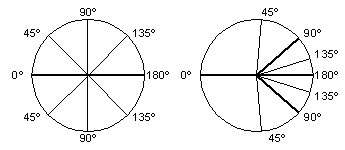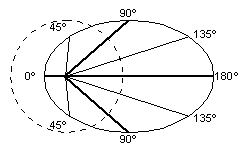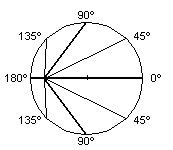 ,
,
Abstract: Section 7 of Einstein's 1905 electrodynamics paper gives frequency-shift and aberration formulae that together describe an elongated ellipsoidal wavefront. A Lorentz contraction of this ellipsoid solves most (but not all) of the associated relativistic problems. |
These ellipsoids can be given a spherical outline either by introducing curvature effects that preserve the internal light-ray distances as geodesics, or by introducing a simple contraction along the motion axis. SR uses the latter option.
 , , |
. . . (1) |
 Fig. 1. - SR angle-change at v=0.75c |
 |
. . . (2) |
This second formula extends or retracts the ray-distances shown in figure 1 to give a rather more elegant diagram that combines aberration and wavelength-change effects.
 Fig. 2. - SR angle-change and wavelength-change at v=0.75c |
Note that to get this result, the angle used to calculate an observed frequency shift should be the angle that is seen by the observer, (i.e. the angle after an aberration formula has already been applied [5] ).
However, since the special theory requires the behavior of light to be unaffected by the motion of the source ( "continuum spatii et temporis est absolutum" [6] ), the wavefront ought to appear to be spherical irrespective of any relative motion between source and emitter. SR's simple solution is to apply a contraction of the coordinate system along the motion axis so that all measured distances parallel to this axis are shortened by the Lorentz factor, turning figure 2 into figure 3.
 Fig. 3. - SR ellipse after Lorentz contraction (v=0.75c) |
This gives a spherical surface exactly centered on the position occupied by the object at the moment of emission, with the rays intersecting the sphere at precisely the same positions that we would expect if the emitter had not been moving. If the radius of the sphere is c metres, the displacement of the object from the center turns out to be exactly v metres - in other words, this offset is simply the distance that the object has moved in the time represented by the wavefront radius. Since this length v in figure 3 appears on a diagram that is already Lorentz-contracted, it could be argued that this "velocity" measurement is defined in Lorentz-contracted units, and that this description therefore already includes time-dilation and mass-dilation effects (the larger displacement in figure 2 then represents the larger "Newtonian velocity" of the object for the same kinetic energy).
Figure 3 corresponds to figure 4 of Lodge's 1893 paper [7], and shows aberration angles and distances in a system in which lightspeed is fixed throughout space in the observer's frame rather than in the object's. Lorentz contraction therefore has the ability to turn "fixed-emitter" distances into their "fixed-observer" equivalents.
|
|
. . . (3) |
We can now examine the ancestry of the figure 2 ellipse and the associated 1905 equations.
The ellipse shape is a consequence of the principle of relativity - if an emitting object tries to verify that its own expanding wavefront is spherical (and is unaffected by the object's own supposed velocity), it cannot directly observe its own spreading (retreating) wavefront. Instead, it has to rely on indirect observations which involve secondary signals that originate at the wavefront and carry information back to the object (it can see light that reflects off dust particles or other objects struck by the wavefront). If the object assumes fixed c relative to itself, it can define a surrounding array of reflectors as "spherical" if an outgoing pulse appears (to the object) to illuminate all the reflectors at the same time.
To an observer in the emitter's frame, the reflected light-rays are starting and finishing at the same spatial coordinates at the center of a spherical array of reflectors, but an observer in a different frame would disagree. To the second observer, the object would have moved a finite distance between emitting the pulse and receiving the reflection, so while the rays have a common emission-point and a common reception-point, these two points are spatially separated. The assumption of a fixed speed of light relative to this observation results in a diagram in which these two positions lie on the foci of an ellipse that marks out the positions of the illuminated reflectors.
The special theory can interpret this elliptical set of positions by insisting that the reflector array and the spreading wavefront are both still spherical, but that since the array is moving relative to the wavefront in the second case, the reflectors at the rear of the array intercept the light earlier than those at the front, and the individual illumination-events are no longer simultaneous but are spread out in time. The intersection of the "stationary" expanding light-sphere and the "moving" reflector-array produces a moving illuminated ring that passes along the array and eventually draws the elongated spheroid [3]. Special relativity can describe this in terms of a disagreement between frames about simultaneity [8][9].
The dimensions of this ellipse can be uniquely defined by the forward and rearward distances of one focus from the perimeter, which, given the earlier argument about wavelength-changes and distance-changes, is in turn defined by a theory's forward and rearward Doppler shift predictions. Once we have chosen the appropriate non-transverse SR shift formula, much of the rest of the special theory (including equations 1 and 2) appears to be inevitable.
|
|
. . . (4) |
|
|
. . . (5) |
If we want to extend the frame-independence of this result back to the individual one-way observations, we can take the root of this round-trip frequency shift to get a "relativistic" Doppler formula:
![f' = f[(c-v)/(c+v)]^0.5](Baird_9806037_files/e98ab_6.gif) . . |
. . . (6) |
Of these three shift equations, (4) produces an ellipse with constant length but contracted width, (5) generates an ellipse with dilated width and doubly-dilated length, and (6) produces an intermediate ellipse with constant width but dilated length (SR, figure 2). Of the latter two equations, (6) only requires a simple contraction along the motion axis to return the original spherical outline and external dimensions, whereas (5) would seem to require a more complex packing method, and is in any case broadly incompatible with the concept of flat spacetime [13].
Once we have decided to assume flat spacetime and have chosen (6) as our basic shift formula, we have arguably obtained the geometrical essentials of special relativity.
Returning to the description in section III, we find that the local wavelength fragments measured by these observers, when fitted together to generate a map of the region, do not produce the internal spatial dimensions of a fixed-radius sphere. This cannot entirely be blamed on aberration effects [14] - even if we only use three of these observers placed along the motion path (one at the object's position, and one each at the forward and rearward wavefront positions), we find that with the SR shift formula the sum of the forward and rearward distances inside the wavefront, mapped by observed wavelength, increases with velocity according to the Lorentz formula. This is true even though the observers making the map are supposed to be able to claim that these two distances add to give the diameter of a sphere whose radius is unaffected by the velocity of the emitter.
This result is somewhat disquieting. If a spatial map of the region inside a supposedly spherical wavefront includes larger distances than the wavefront's supposed radius in the observers' frame, then the discrepancy implies either that the map does not describe a simple fixed-radius sphere, or that the region of space is not completely Euclidean.
A Lorentz contraction of the region's coordinate system removes these "light-distance" anomalies, but introduces new problems - if an observer thinks themself to be stationary and maps the expanding wavefront to be externally spherical in their own frame, then how can the existence of a moving mass inside the wavefront be used to justify the Lorentz contraction of the region around this moving body? Einstein's introduction to his 1905 paper rejects the idea of "[assigning] a velocity vector to a point in empty space where electromagnetic processes take place", and the theory also does not let us "smudge" the object's mass and motion into the surrounding region via gravitational effects, as this would invalidate the assumption of Euclidean geometry [15].
No consistent approach to tackling the ray-distance problem is known to the author that does not involve velocity-dependent curvature, local mass-fields and/or gravitational dragging as a key part of the explanation. Since all these approaches seem to treat lightspeed constancy between moving masses as a purely local effect, they conflict with the SR assumption of full c-constancy, and we will not consider them further in this paper.
This description is probably the best that we can achieve by assuming flat spacetime, but still leaves the "ray-distance" problem unanswered - how can we justify the contraction of light-distances in the region of spacetime around a moving object, if the object's relative velocity is not supposed to affect the properties of this region or the behavior of its contained light?
A convincing answer to this question would not seem to be possible in a model that relies on Euclidean geometry, so our discussion of "aberration and SR" would seem to reach a natural end at this point.